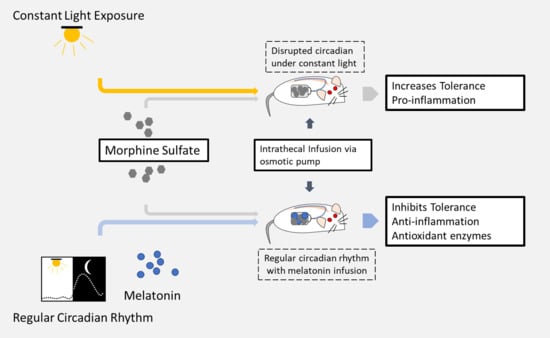The Circadian Hormone Melatonin Inhibits Morphine-Induced Tolerance and Inflammation via the Activation of Antioxidative Enzymes
Abstract
1. Introduction
2. Materials and Methods
2.1. Reagents
2.2. Experimental Design
2.3. Chronic Constriction Injury
2.4. Intrathecal Drug Delivery
2.5. Nociceptive Test
2.6. Cell Culture
2.7. Spinal Cord Sample Preparation
2.8. Western Blot Analysis
2.9. RNA Extraction and Quantitative PCR
2.10. Statistical Analysis
3. Results
3.1. Constant Light Exposure Aggravate Morphine Tolerance in Neuropathic Rats
3.2. Exogenous Low-Dose Melatonin Inhibited Morphine Tolerance Independently of Melatonin Receptors
3.3. Melatonin Upregulated Antioxidative Enzymes and Decreased Proinflammatory Gene Expression in Morphine-Tolerant Rats
4. Discussion
5. Conclusions
Supplementary Materials
Author Contributions
Funding
Acknowledgments
Conflicts of Interest
References
- Boudreau, D.M.; Von Korff, M.; Rutter, C.M.; Saunders, K.; Ray, G.T.; Sullivan, M.D.; Campbell, C.I.; Merrill, J.O.; Silverberg, M.J.; Banta-Green, M.C.J.; et al. Trends in long-term opioid therapy for chronic non-cancer pain. Pharmacoepidemiol. Drug Saf. 2009, 18, 1166–1175. [Google Scholar] [CrossRef] [PubMed]
- Trang, T.; Al-Hasani, R.; Salvemini, D.; Salter, M.W.; Gutstein, H.; Cahill, C.M. Pain and Poppies: The Good, the Bad, and the Ugly of Opioid Analgesics. J. Neurosci. 2015, 35, 13879–13888. [Google Scholar] [CrossRef]
- Colvin, L.A.; Bull, F.A.; Hales, T.G. Perioperative opioid analgesia-when is enough too much? A review of opioid-induced tolerance and hyperalgesia. Lancet 2019, 393, 1558–1568. [Google Scholar] [CrossRef]
- Okie, S. A Flood of Opioids, a Rising Tide of Deaths. N. Engl. J. Med. 2010, 363, 1981–1985. [Google Scholar] [CrossRef] [PubMed]
- Paulozzi, L.J.; Weisler, R.H.; Patkar, A.A. A National Epidemic of Unintentional Prescription Opioid Overdose Deaths: How Physicians Can Help Control It. J. Clin. Psychiatr. 2011, 72, 589–592. [Google Scholar] [CrossRef]
- Bohnert, A.S.; Ilgen, M.A. Understanding Links among Opioid Use, Overdose, and Suicide. N. Engl. J. Med. 2019, 380, 71–79. [Google Scholar] [CrossRef] [PubMed]
- Mathias, J.; Cant, M.; Burke, A. Sleep disturbances and sleep disorders in adults living with chronic pain: A meta-analysis. Sleep Med. 2018, 52, 198–210. [Google Scholar] [CrossRef]
- Musiek, E.S.; Holtzman, D.M. Mechanisms linking circadian clocks, sleep, and neurodegeneration. Science 2016, 354, 1004–1008. [Google Scholar] [CrossRef]
- Bruguerolle, B.; Labrecque, G. Rhythmic pattern in pain and their chronotherapy. Adv. Drug Deliv. Rev. 2007, 59, 883–895. [Google Scholar] [CrossRef]
- Junker, U.; Wirz, S. Review Article: Chronobiology: Influence of circadian rhythms on the therapy of severe pain. J. Oncol. Pharm. Pract. 2010, 16, 81–87. [Google Scholar] [CrossRef]
- Morris, R.W.; Lutsch, E.F. Susceptibility to Morphine-induced Analgesia in Mice. Nature 1967, 216, 494–495. [Google Scholar] [CrossRef] [PubMed]
- Kavaliers, M.; Hirst, M. Daily rhythms of analgesia in mice: Effects of age and photoperiod. Brain Res. 1983, 279, 387–393. [Google Scholar] [CrossRef]
- Schiessl, C.; Schestag, I.; Sittl, R.; Drake, R.; Zernikow, B. Rhythmic pattern of PCA opioid demand in adults with cancer pain. Eur. J. Pain 2010, 14, 372–379. [Google Scholar] [CrossRef] [PubMed]
- Kervezee, L.; Hartman, R.; van den Berg, D.-J.; Meijer, J.H.; De Lange, E.C. Diurnal variation in the pharmacokinetics and brain distribution of morphine and its major metabolite. Eur. J. Pharm. Sci. 2017, 109, S132–S139. [Google Scholar] [CrossRef] [PubMed]
- Claustrat, B.; Brun, J.; Chazot, G. The basic physiology and pathophysiology of melatonin. Sleep Med. Rev. 2005, 9, 11–24. [Google Scholar] [CrossRef]
- Bach, A.G.; Mühlbauer, E.; Peschke, E. Adrenoceptor Expression and Diurnal Rhythms of Melatonin and Its Precursors in the Pineal Gland of Type 2 Diabetic Goto-Kakizaki Rats. Endocrinology 2010, 151, 2483–2493. [Google Scholar] [CrossRef]
- Hébert, M.; Martin, S.K.; Lee, C.; Eastman, C.I. The effects of prior light history on the suppression of melatonin by light in humans. J. Pineal Res. 2002, 33, 198–203. [Google Scholar] [CrossRef]
- Lewy, A.; Wehr, T.; Goodwin, F.; Newsome, D.; Markey, S. Light suppresses melatonin secretion in humans. Science 1980, 210, 1267–1269. [Google Scholar] [CrossRef]
- Bruce, J.; Tamarkin, L.; Riedel, C.; Markey, S.; Oldfield, E. Sequential Cerebrospinal Fluid and Plasma Sampling in Humans: 24-Hour Melatonin Measurements in Normal Subjects and after Peripheral Sympathectomy. J. Clin. Endocrinol. Metab. 1991, 72, 819–823. [Google Scholar] [CrossRef]
- Mirick, D.K.; Davis, S. Melatonin as a Biomarker of Circadian Dysregulation. Cancer Epidemiol. Biomark. Prev. 2008, 17, 3306–3313. [Google Scholar] [CrossRef]
- Srinivasan, V.; Pandi-Perumal, S.R.; Spence, D.; Moscovitch, A.; Trakht, I.; Brown, G.M.; Cardinali, D.P. Potential use of melatonergic drugs in analgesia: Mechanisms of action. Brain Res. Bull. 2010, 81, 362–371. [Google Scholar] [CrossRef] [PubMed]
- Borsani, E.; Buffoli, B.; Bonazza, V.; Reiter, R.J.; Rezzani, R.; Rodella, L. Single Administration of Melatonin Modulates the Nitroxidergic System at the Peripheral Level and Reduces Thermal Nociceptive Hypersensitivity in Neuropathic Rats. Int. J. Mol. Sci. 2017, 18, 2143. [Google Scholar] [CrossRef] [PubMed]
- Zurowski, D.; Nowak, L.; Machowska, A.; Wordliczek, J.; Thor, P.J. Exogenous melatonin abolishes mechanical allodynia but not thermal hyperalgesia in neuropathic pain. The role of the opioid system and benzodiazepine-gabaergic mechanism. J. Physiol. Pharmacol. Off. J. Pol. Physiol. Soc. 2012, 63, 641–647. [Google Scholar]
- Huang, C.-T.; Chiang, R.P.-Y.; Chen, C.-L.; Tsai, Y.-J. Sleep Deprivation Aggravates Median Nerve Injury-Induced Neuropathic Pain and Enhances Microglial Activation by Suppressing Melatonin Secretion. Sleep 2014, 37, 1513–1523. [Google Scholar] [CrossRef]
- Costello, R.B.; Lentino, C.V.; Boyd, C.C.; O’Connell, M.; Crawford, C.C.; Sprengel, M.; Deuster, P.A. The effectiveness of melatonin for promoting healthy sleep: A rapid evidence assessment of the literature. Nutr. J. 2014, 13, 106. [Google Scholar] [CrossRef]
- Vural, E.M.S.; Van Munster, B.C.; De Rooij, S.E. Optimal Dosages for Melatonin Supplementation Therapy in Older Adults: A Systematic Review of Current Literature. Drugs Aging 2014, 31, 441–451. [Google Scholar] [CrossRef]
- Andersen, L.P.K.; Werner, M.U.; Rosenkilde, M.M.; Harpsøe, N.G.; Fuglsang, H.; Rosenberg, J.; Gögenur, I. Pharmacokinetics of oral and intravenous melatonin in healthy volunteers. BMC Pharmacol. Toxicol. 2016, 17, 8. [Google Scholar] [CrossRef]
- Andersen, L.P.H.; Gögenur, I.; Fenger, A.Q.; Petersen, M.C.; Rosenberg, J.; Werner, M.U. Analgesic and antihyperalgesic effects of melatonin in a human inflammatory pain model. Pain 2015, 156, 2286–2294. [Google Scholar] [CrossRef]
- Andersen, L.P.K.; Werner, M.U.; Rosenberg, J.; Gögenur, I. A systematic review of peri-operative melatonin. Anaesthesia 2014, 69, 1163–1171. [Google Scholar] [CrossRef]
- Hemati, K.; Pourhanifeh, M.H.; Dehdashtian, E.; Fatemi, I.; Mehrzadi, S.; Reiter, R.J.; Hosseinzadeh, A. Melatonin and morphine: Potential beneficial effects of co-use. Fundam. Clin. Pharmacol. 2020. [Google Scholar] [CrossRef]
- Raghavendra, V.; Kulkarni, S.K. Reversal of morphine tolerance and dependence by melatonin: Possible role of central and peripheral benzodiazepine receptors. Brain Res. 1999, 834, 178–181. [Google Scholar] [CrossRef]
- Raghavendra, V.; Kulkarni, S. Possible mechanisms of action in melatonin reversal of morphine tolerance and dependence in mice. Eur. J. Pharmacol. 2000, 409, 279–289. [Google Scholar] [CrossRef]
- Zahn, P.K.; Lansmann, T.; Berger, E.; Speckmann, E.-J.; Musshoff, U. Gene expression and functional characterization of melatonin receptors in the spinal cord of the rat: Implications for pain modulation. J. Pineal Res. 2003, 35, 24–31. [Google Scholar] [CrossRef] [PubMed]
- Pang, C.; Tsang, S.; Yang, J. Effects of melatonin, morphine and diazepam on formalin-induced nociception in mice. Life Sci. 2001, 68, 943–951. [Google Scholar] [CrossRef]
- Garmabi, B.; Vousooghi, N.; Vosough, M.; Yoonessi, A.; Bakhtazad, A.; Zarrindast, M. Effect of circadian rhythm disturbance on morphine preference and addiction in male rats: Involvement of period genes and dopamine D1 receptor. J. Neurosci. 2016, 322, 104–114. [Google Scholar] [CrossRef]
- Fan, Y.; Liang, X.; Wang, R.; Song, L. Role of endogenous melatoninergic system in development of hyperalgesia and tolerance induced by chronic morphine administration in rats. Brain Res. Bull. 2017, 135, 105–112. [Google Scholar] [CrossRef]
- Song, L.; Wu, C.; Zuo, Y.-X. Melatonin prevents morphine-induced hyperalgesia and tolerance in rats: Role of protein kinase C and N-methyl-D-aspartate receptors. BMC Anesthesiol. 2015, 15, 12. [Google Scholar] [CrossRef]
- Lin, S.-H.; Huang, Y.-N.; Kao, J.-H.; Tien, L.-T.; Tsai, R.-Y.; Wong, C.-S. Melatonin reverses morphine tolerance by inhibiting microglia activation and HSP27 expression. Life Sci. 2016, 152, 38–43. [Google Scholar] [CrossRef]
- Cheng, Y.; Tsai, R.; Sung, Y.; Chen, I.-J.; Tu, T.; Mao, Y.; Wong, C. Melatonin regulation of transcription in the reversal of morphine tolerance: Microarray analysis of differential gene expression. Int. J. Mol. Med. 2019, 43, 791–806. [Google Scholar] [CrossRef]
- Shen, C.-H.; Tsai, R.-Y.; Shih, M.-S.; Lin, S.-L.; Tai, Y.-H.; Chien, C.-C.; Wong, C.-S. Etanercept Restores the Antinociceptive Effect of Morphine and Suppresses Spinal Neuroinflammation in Morphine-Tolerant Rats. Anesth. Analg. 2011, 112, 454–459. [Google Scholar] [CrossRef]
- Wen, Z.-H.; Wu, G.-J.; Chang, Y.-C.; Wang, J.-J.; Wong, C.-S. Dexamethasone modulates the development of morphine tolerance and expression of glutamate transporters in rats. J. Neurosci. 2005, 133, 807–817. [Google Scholar] [CrossRef] [PubMed]
- Austin, P.J.; Wu, A.; Moalem-Taylor, G. Chronic Constriction of the Sciatic Nerve and Pain Hypersensitivity Testing in Rats. J. Vis. Exp. 2012. [Google Scholar] [CrossRef] [PubMed]
- Tai, Y.-H.; Wang, Y.-H.; Wang, J.-J.; Tao, P.-L.; Tung, C.-S.; Wong, C.-S. Amitriptyline suppresses neuroinflammation and up-regulates glutamate transporters in morphine-tolerant rats. Pain 2006, 124, 77–86. [Google Scholar] [CrossRef] [PubMed]
- Tétreault, P.; Dansereau, M.-A.; Doré-Savard, L.; Beaudet, N.; Sarret, P. Weight bearing evaluation in inflammatory, neuropathic and cancer chronic pain in freely moving rats. Physiol. Behav. 2011, 104, 495–502. [Google Scholar] [CrossRef] [PubMed]
- Tan, D.-X.; Manchester, L.C.; Terron, M.P.; Flores-Alvarado, L.J.; Reiter, R.J. One molecule, many derivatives: A never-ending interaction of melatonin with reactive oxygen and nitrogen species? J. Pineal Res. 2007, 42, 28–42. [Google Scholar] [CrossRef] [PubMed]
- Skrabalova, J.; Drastichova, Z.; Novotny, J. Morphine as a Potential Oxidative Stress-Causing Agent. Mini Rev. Org. Chem. 2013, 10, 367–372. [Google Scholar] [CrossRef] [PubMed]
- Dringen, R. Oxidative and Antioxidative Potential of Brain Microglial Cells. Antioxid. Redox Signal. 2005, 7, 1223–1233. [Google Scholar] [CrossRef]
- Okubo, M.; Yamanaka, H.; Kobayashi, K.; Noguchi, K. Leukotriene synthases and the receptors induced by peripheral nerve injury in the spinal cord contribute to the generation of neuropathic pain. Glia 2010, 58, 599–610. [Google Scholar] [CrossRef]
- Cortes-Burgos, L.A.; Zweifel, B.S.; Settle, S.L.; Pufahl, R.A.; Anderson, G.D.; Hardy, M.M.; Weir, D.E.; Hu, G.; Happa, F.A.; Stewart, Z.; et al. CJ-13610, an orally active inhibitor of 5-lipoxygenase is efficacious in preclinical models of pain. Eur. J. Pharmacol. 2009, 617, 59–67. [Google Scholar] [CrossRef]
- Aley, K.; Levine, J.D. Contribution of 5- and 12-lipoxygenase products to mechanical hyperalgesia induced by prostaglandin E2 and epinephrine in the rat. Exp. Brain Res. 2003, 148, 482–487. [Google Scholar] [CrossRef]
- Illias, A.M.; Gist, A.C.; Zhang, H.; Kosturakis, A.K.; Dougherty, P.M. Chemokine CCL2 and its receptor CCR2 in the dorsal root ganglion contribute to oxaliplatin-induced mechanical hypersensitivity. Pain 2018, 159, 1308–1316. [Google Scholar] [CrossRef] [PubMed]
- Yamasaki, R.; Liu, L.; Lin, J.; Ransohoff, R.M. Role of CCR2 in immunobiology and neurobiology. Clin. Exp. Neuroimmunol. 2011, 3, 16–29. [Google Scholar] [CrossRef]
- Thacker, M.A.; Clark, A.K.; Marchand, F.; McMahon, S.B. Pathophysiology of Peripheral Neuropathic Pain: Immune Cells and Molecules. Anesth. Analg. 2007, 105, 838–847. [Google Scholar] [CrossRef] [PubMed]
- Huang, W.-J.; Chen, W.-W.; Zhang, X. Endocannabinoid system: Role in depression, reward and pain control (Review). Mol. Med. Rep. 2016, 14, 2899–2903. [Google Scholar] [CrossRef] [PubMed]
- Zhang, M.; Wang, K.; Ma, M.; Tian, S.; Wei, N.; Wang, G. Low-Dose Cannabinoid Type 2 Receptor Agonist Attenuates Tolerance to Repeated Morphine Administration Via Regulating Mu-Opioid Receptor Expression in Walker 256 Tumor-Bearing Rats. Anesth. Analg. 2016, 122, 1031–1037. [Google Scholar] [CrossRef] [PubMed]
- Boucher, T.J.; Okuse, K.; Bennett, D.L.; Munson, J.B.; Wood, J.N.; McMahon, S.B. Potent Analgesic Effects of GDNF in Neuropathic Pain States. Science 2000, 290, 124–127. [Google Scholar] [CrossRef]
- Ding, Z.; Xu, W.; Zhang, J.; Zou, W.; Guo, Q.; Huang, C.-S.; Liu, C.; Zhong, T.; Zhang, J.-M.; Song, Z. Normalizing GDNF expression in the spinal cord alleviates cutaneous hyperalgesia but not ongoing pain in a rat model of bone cancer pain. Int. J. Cancer 2017, 140, 411–422. [Google Scholar] [CrossRef]
- Iwasa, T.; Afroz, S.; Inoue, M.; Arakaki, R.; Oshima, M.; Raju, R.; Waskitho, A.; Inoue, M.; Baba, O.; Matsuka, Y. IL-10 and CXCL2 in trigeminal ganglia in neuropathic pain. Neurosci. Lett. 2019, 703, 132–138. [Google Scholar] [CrossRef]
- Vanderwall, A.G.; Milligan, E. Cytokines in Pain: Harnessing Endogenous Anti-Inflammatory Signaling for Improved Pain Management. Front. Immunol. 2019, 10, 3009. [Google Scholar] [CrossRef]
- Mika, J.; Korostynski, M.; Kaminska, D.; Wawrzczak-Bargiela, A.; Osikowicz, M.; Makuch, W.; Przewlocki, R.; Przewlocka, B. Interleukin-1alpha has antiallodynic and antihyperalgesic activities in a rat neuropathic pain model. Pain 2008, 138, 587–597. [Google Scholar] [CrossRef]
- Paish, H.L.; Kalson, N.S.; Smith, G.R.; Pons, A.D.C.; Baldock, T.E.; Smith, N.; Swist-Szulik, K.; Weir, D.J.; Bardgett, M.; Deehan, D.J.; et al. Fibroblasts Promote Inflammation and Pain via IL-1α Induction of the Monocyte Chemoattractant Chemokine (C-C Motif) Ligand 2. Am. J. Pathol. 2018, 188, 696–714. [Google Scholar] [CrossRef] [PubMed]
- Pilat, D.; Rojewska, E.; Jurga, A.M.; Piotrowska, A.; Makuch, W.; Przewlocka, B.; Mika, J. IL-1 receptor antagonist improves morphine and buprenorphine efficacy in a rat neuropathic pain model. Eur. J. Pharmacol. 2015, 764, 240–248. [Google Scholar] [CrossRef] [PubMed]
- Raghavendra, V.; Rutkowski, M.D.; DeLeo, J. The Role of Spinal Neuroimmune Activation in Morphine Tolerance/Hyperalgesia in Neuropathic and Sham-Operated Rats. J. Neurosci. 2002, 22, 9980–9989. [Google Scholar] [CrossRef] [PubMed]
- Guo, Y.-P.; Zhi, Y.-R.; Liu, T.-T.; Wang, Y.; Zhang, Y. Global Gene Knockout of Kcnip3 Enhances Pain Sensitivity and Exacerbates Negative Emotions in Rats. Front. Mol. Neurosci. 2019, 12, 5. [Google Scholar] [CrossRef]
- Tian, N.-X.; Xu, Y.; Yang, J.-Y.; Li, L.; Sun, X.-H.; Wang, Y.; Zhang, Y. KChIP3 N-Terminal 31-50 Fragment Mediates Its Association with TRPV1 and Alleviates Inflammatory Hyperalgesia in Rats. J. Neurosci. 2018, 38, 1756–1773. [Google Scholar] [CrossRef]
- Funk, C.D. Prostaglandins and Leukotrienes: Advances in Eicosanoid Biology. Science 2001, 294, 1871–1875. [Google Scholar] [CrossRef]
- Zhou, Q.-Y.; Cheng, M.Y. Prokineticin 2 and circadian clock output. FEBS J. 2005, 272, 5703–5709. [Google Scholar] [CrossRef]
- Maftei, D.; Marconi, V.; Florenzano, F.; Giancotti, L.A.; Castelli, M.; Moretti, S.; Borsani, E.; Rodella, L.F.; Balboni, G.; Luongo, S.; et al. Controlling the Activation of the Bv8/Prokineticin System Reduces Neuroinflammation and Abolishes Thermal and Tactile Hyperalgesia in Neuropathic Animals. Br. J. Pharmacol. 2014, 171, 4850–4865. [Google Scholar] [CrossRef]
- Singh, A.K.; Zajdel, J.; Mirrasekhian, E.; Almoosawi, N.; Frisch, I.; Klawonn, A.M.; Jaarola, M.; Fritz, M.; Engblom, D. Prostaglandin-Mediated inhibition of serotonin signaling controls the affective component of inflammatory pain. J. Clin. Investig. 2017, 127, 1370–1374. [Google Scholar] [CrossRef]
- Treutlein, E.-M.; Kern, K.; Weigert, A.; Tarighi, N.; Schuh, C.-D.; Nüsing, R.M.; Schreiber, Y.; Ferreirós, N.; Brüne, B.; Geisslinger, G.; et al. The prostaglandin E2 receptor EP3 controls CC-chemokine ligand 2–mediated neuropathic pain induced by mechanical nerve damage. J. Biol. Chem. 2018, 293, 9685–9695. [Google Scholar] [CrossRef]
- Jin, Y.; Smith, C.; Hu, L.; Coutant, D.E.; Whitehurst, K.; Phipps, K.; McNearney, T.A.; Yang, X.; Ackermann, B.; Pottanat, T.; et al. LY3127760, a Selective Prostaglandin E4 (EP4) Receptor Antagonist, and Celecoxib: A Comparison of Pharmacological Profiles. Clin. Transl. Sci. 2018, 11, 46–53. [Google Scholar] [CrossRef] [PubMed]
- Leng, X.-R.; Qi, X.-H.; Zhou, Y.-T.; Wang, Y.-P. Gain-of-function mutation p.Arg225Cys in SCN11A causes familial episodic pain and contributes to essential tremor. J. Hum. Genet. 2017, 62, 641–646. [Google Scholar] [CrossRef] [PubMed]
- Vandewauw, I.; De Clercq, K.; Mulier, M.; Held, K.; Pinto, S.; Van Ranst, N.; Segal, A.; Voet, T.; Vennekens, R.; Zimmermann, K.; et al. A TRP channel trio mediates acute noxious heat sensing. Nature 2018, 555, 662–666. [Google Scholar] [CrossRef] [PubMed]
- Takayama, Y.; Derouiche, S.; Maruyama, K.; Tominaga, M. Emerging Perspectives on Pain Management by Modulation of TRP Channels and ANO1. Int. J. Mol. Sci. 2019, 20, 3411. [Google Scholar] [CrossRef]
- Lee, H.; Ahn, S.; Ann, J.; Ha, H.; Yoo, Y.D.; Kim, Y.H.; Hwang, J.-Y.; Hur, K.-H.; Jang, C.-G.; Pearce, L.V.; et al. Discovery of dual-acting opioid ligand and TRPV1 antagonists as novel therapeutic agents for pain. Eur. J. Med. Chem. 2019, 182, 111634. [Google Scholar] [CrossRef]
- Wideman, C.H.; Murphy, H.M. Constant light induces alterations in melatonin levels, food intake, feed efficiency, visceral adiposity, and circadian rhythms in rats. Nutr. Neurosci. 2009, 12, 233–240. [Google Scholar] [CrossRef]
- Zhdanova, I.V.; Wurtman, R.J.; Regan, M.M.; Taylor, J.A.; Shi, J.P.; Leclair, O.U. Melatonin Treatment for Age-Related Insomnia. J. Clin. Endocrinol. Metab. 2001, 86, 4727–4730. [Google Scholar] [CrossRef]
- Lewy, A.J.; Emens, J.S.; Lefler, B.J.; Yuhas, K.; Jackman, A.R. Melatonin Entrains Free-Running Blind People According to a Physiological Dose-response Curve. Chronobiol. Int. 2005, 22, 1093–1106. [Google Scholar] [CrossRef]
- Kuthati, Y.; Lin, S.-H.; Chen, I.-J.; Wong, C.-S. Melatonin and their analogs as a potential use in the management of Neuropathic pain. J. Formos. Med Assoc. 2019, 118, 1177–1186. [Google Scholar] [CrossRef]
- Posa, L.; De Gregorio, D.; Gobbi, G.; Comai, S. Targeting Melatonin MT2 Receptors: A Novel Pharmacological Avenue for Inflammatory and Neuropathic Pain. Curr. Med. Chem. 2018, 25, 3866–3882. [Google Scholar] [CrossRef]
- Ebadi, M.; Govitrapong, P.; Phansuwan-Pujitu, P.; Nelson, F.; Reiter, R.J. Pineal opioid receptors and analgesic action of melatonin. J. Pineal Res. 1998, 24, 193–200. [Google Scholar] [CrossRef] [PubMed]
- Ambriz-Tututi, M.; Granados-Soto, V. Oral and spinal melatonin reduces tactile allodynia in rats via activation of MT2 and opioid receptors. Pain 2007, 132, 273–280. [Google Scholar] [CrossRef] [PubMed]
- Lin, J.-J.; Lin, Y.; Zhao, T.-Z.; Zhang, C.-K.; Zhang, T.; Chen, X.-L.; Ding, J.-Q.; Chang, T.; Zhang, Z.; Sun, C.; et al. Melatonin Suppresses Neuropathic Pain via MT2-Dependent and -Independent Pathways in Dorsal Root Ganglia Neurons of Mice. Theranostics 2017, 7, 2015–2032. [Google Scholar] [CrossRef] [PubMed]
- Liu, Q.; Su, L.-Y.; Sun, C.; Jiao, L.; Miao, Y.; Xu, M.; Luo, R.; Zuo, X.; Zhou, R.; Zheng, P.; et al. Melatonin alleviates morphine analgesic tolerance in mice by decreasing NLRP3 inflammasome activation. Redox Biol. 2020, 34, 101560. [Google Scholar] [CrossRef]
- Tan, D.-X.; Manchester, L.C.; Esteban-Zubero, E.; Zhou, Z.; Reiter, R.J. Melatonin as a Potent and Inducible Endogenous Antioxidant: Synthesis and Metabolism. Molecules 2015, 20, 18886–18906. [Google Scholar] [CrossRef]
- Chen, L.-Y.; Renn, T.-Y.; Liao, W.-C.; Mai, F.-D.; Ho, Y.-J.; Hsiao, G.; Lee, A.-W.; Chang, H.-M. Melatonin successfully rescues hippocampal bioenergetics and improves cognitive function following drug intoxication by promoting Nrf2-ARE signaling activity. J. Pineal Res. 2017, 63, e12417. [Google Scholar] [CrossRef]
- Ali, T.; Rehman, S.U.; Shah, F.A.; Kim, M.O. Acute dose of melatonin via Nrf2 dependently prevents acute ethanol-induced neurotoxicity in the developing rodent brain. J. Neuroinflamm. 2018, 15, 119. [Google Scholar] [CrossRef]
- Ding, K.; Wang, H.; Xu, J.; Li, T.; Zhang, L.; Ding, Y.; Zhu, L.; He, J.; Zhou, M. Melatonin stimulates antioxidant enzymes and reduces oxidative stress in experimental traumatic brain injury: The Nrf2-ARE signaling pathway as a potential mechanism. Free Radic. Biol. Med. 2014, 73, 1–11. [Google Scholar] [CrossRef]
- Wang, J.; Jiang, C.; Zhang, K.; Lan, X.; Chen, X.; Zang, W.; Wang, Z.; Guan, F.; Zhu, C.; Yang, X.; et al. Melatonin receptor activation provides cerebral protection after traumatic brain injury by mitigating oxidative stress and inflammation via the Nrf2 signaling pathway. Free Radic. Biol. Med. 2019, 131, 345–355. [Google Scholar] [CrossRef]
- Redondo, A.; Chamorro, P.A.F.; Riego, G.; Leanez, S.; Pol, O. Treatment with Sulforaphane Produces Antinociception and Improves Morphine Effects during Inflammatory Pain in Mice. J. Pharmacol. Exp. Ther. 2017, 363, 293–302. [Google Scholar] [CrossRef]
- Zhou, Y.-Q.; Gao, F.; Liu, D.-Q. Targeting Cytokines for Morphine Tolerance: A Narrative Review. Curr. Neuropharmacol. 2019, 17, 366–376. [Google Scholar] [CrossRef]
- Hardeland, R. Melatonin and inflammation-Story of a double-edged blade. J. Pineal Res. 2018, 65, e12525. [Google Scholar] [CrossRef] [PubMed]
- Carrión, A.M.; Link, W.; Ledo, F.; Mellström, B.; Naranjo, J. DREAM is a Ca2+-regulated transcriptional repressor. Nature 1999, 398, 80–84. [Google Scholar] [CrossRef] [PubMed]
- Cheng, H.-Y.M.; Pitcher, G.M.; LaViolette, S.R.; Whishaw, I.Q.; Tong, K.I.; Kockeritz, L.K.; Wada, T.; Joza, N.A.; Crackower, M.; Goncalves, J.; et al. DREAM Is a Critical Transcriptional Repressor for Pain Modulation. Cell 2002, 108, 31–43. [Google Scholar] [CrossRef]
- Rivera-Arconada, I.; Benedet, T.; Roza, C.; Torres, B.; Barrio, J.; Krzyzanowska, A.; Avendaño, C.; Mellstrom, B.; Lopez-Garcia, J.A.; Naranjo, J. DREAM regulates BDNF-dependent spinal sensitization. Mol. Pain 2010, 6, 95. [Google Scholar] [CrossRef]
- Zhang, Y.; Su, P.; Liang, P.; Liu, T.; Liu, X.; Liu, X.-Y.; Zhang, B.; Han, T.; Zhu, Y.-B.; Yin, N.-M.; et al. The DREAM Protein Negatively Regulates the NMDA Receptor through Interaction with the NR1 Subunit. J. Neurosci. 2010, 30, 7575–7586. [Google Scholar] [CrossRef]
- Link, W.; Ledo, F.; Torres, B.; Palczewska, M.; Madsen, T.M.; Savignac, M.; Albar, J.P.; Mellström, B.; Naranjo, J. Day-Night Changes in Downstream Regulatory Element Antagonist Modulator/Potassium Channel Interacting Protein Activity Contribute to Circadian Gene Expression in Pineal Gland. J. Neurosci. 2004, 24, 5346–5355. [Google Scholar] [CrossRef]
- Rivas, M.; Aurrekoetxea, K.; Mellström, B.; Naranjo, J. Redox Signaling Regulates Transcriptional Activity of the Ca2+-Dependent Repressor DREAM. Antioxid. Redox Signal. 2011, 14, 1237–1243. [Google Scholar] [CrossRef]
- Oh, S.N.; Myung, S.-K.; Jho, H.J. Analgesic Efficacy of Melatonin: A Meta-Analysis of Randomized, Double-Blind, Placebo-Controlled Trials. J. Clin. Med. 2020, 9, 1553. [Google Scholar] [CrossRef]
- Akbari, M.; Ostadmohammadi, V.; Tabrizi, R.; Lankarani, K.B.; Heydari, S.T.; Amirani, E.; Reiter, R.J.; Asemi, Z. The effects of melatonin supplementation on inflammatory markers among patients with metabolic syndrome or related disorders: A systematic review and meta-analysis of randomized controlled trials. Inflammopharmacology 2018, 26, 899–907. [Google Scholar] [CrossRef]
- Seely, D.; Wu, P.; Fritz, H.; Kennedy, D.A.; Tsui, T.; Seely, A.J.; Mills, E. Melatonin as Adjuvant Cancer Care with and without Chemotherapy: A Systematic Review and Meta-Analysis of Randomized Trials. Integr. Cancer Ther. 2012, 11, 293–303. [Google Scholar] [CrossRef] [PubMed]
- Thorpe, J.; Shum, B.; Moore, R.A.; Wiffen, P.J.; Gilron, I. Combination pharmacotherapy for the treatment of fibromyalgia in adults. Cochrane Database Syst. Rev. 2018, 2018, CD010585. [Google Scholar] [CrossRef] [PubMed]
- Zarezadeh, M.; Khorshidi, M.; Emami, M.; Janmohammadi, P.; Kord-Varkaneh, H.; Mousavi, S.M.; Mohammed, S.H.; Saedisomeolia, A.; Alizadeh, S. Melatonin supplementation and pro-inflammatory mediators: A systematic review and meta-analysis of clinical trials. Eur. J. Nutr. 2019, 59, 1–11. [Google Scholar] [CrossRef] [PubMed]
- Nahin, R.L.; Sayer, B.; Stussman, B.J.; Feinberg, T.M. Eighteen-Year Trends in the Prevalence of, and Health Care Use for, Noncancer Pain in the United States: Data from the Medical Expenditure Panel Survey. J. Pain 2019, 20, 796–809. [Google Scholar] [CrossRef] [PubMed]
- Hayes, C.J.; Krebs, E.E.; Hudson, T.; Brown, J.; Li, C.; Martin, B.C. Impact of opioid dose escalation on the development of substance use disorders, accidents, self-inflicted injuries, opioid overdoses and alcohol and non-opioid drug-related overdoses: A retrospective cohort study. Addiction 2020, 115, 1098–1112. [Google Scholar] [CrossRef]
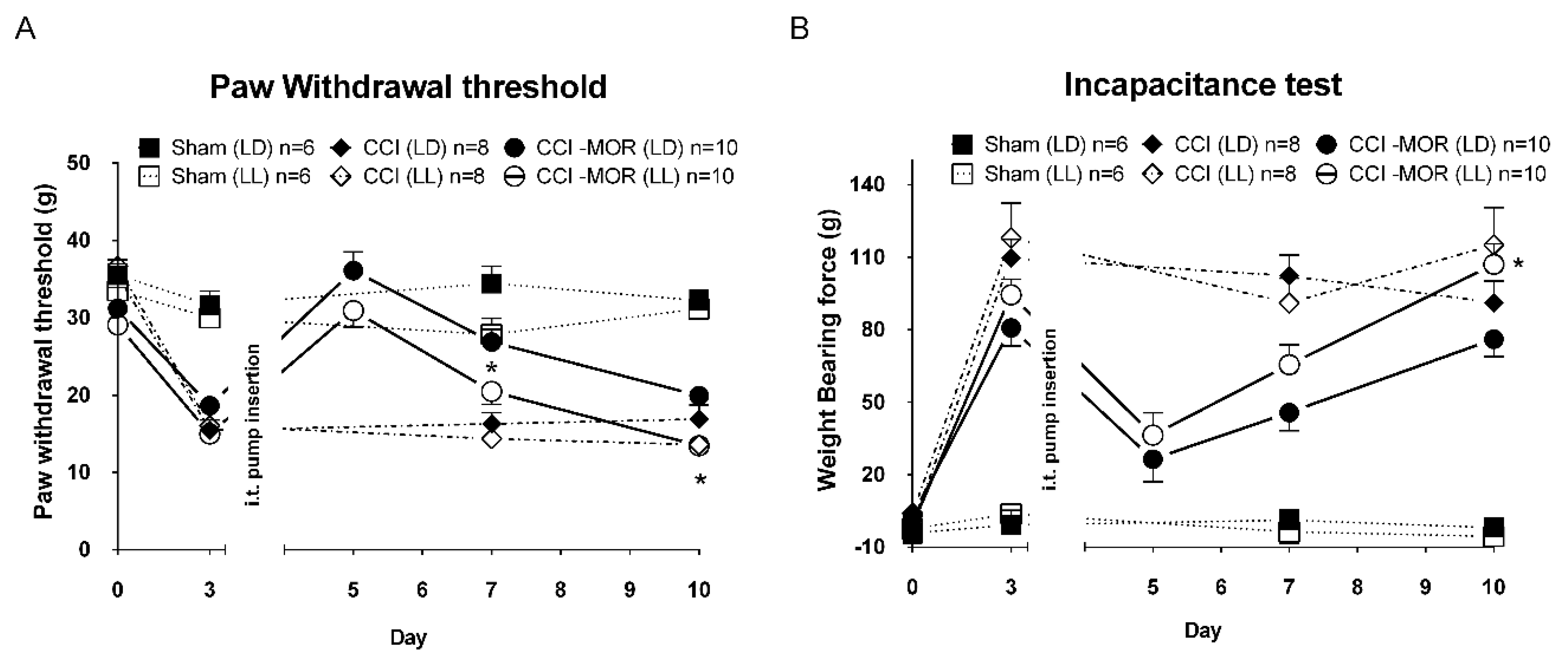
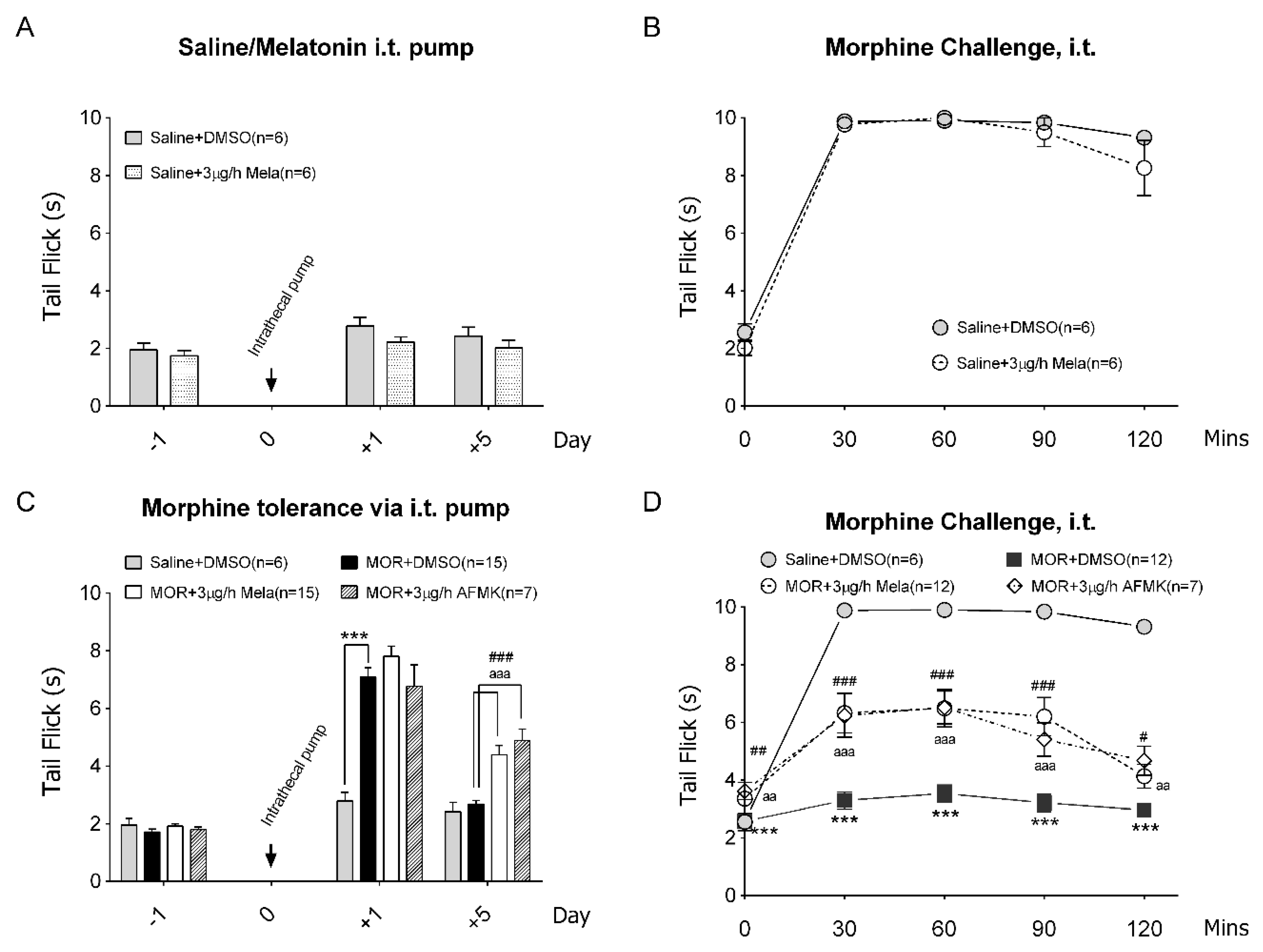

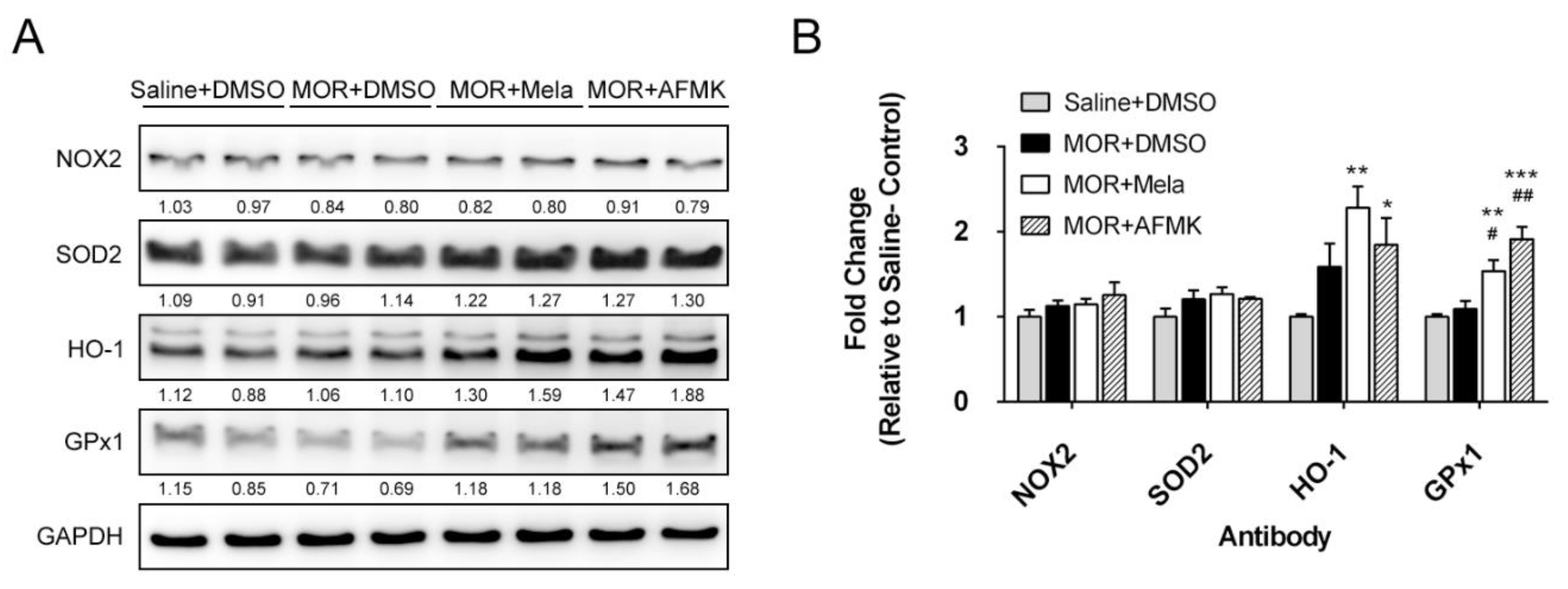
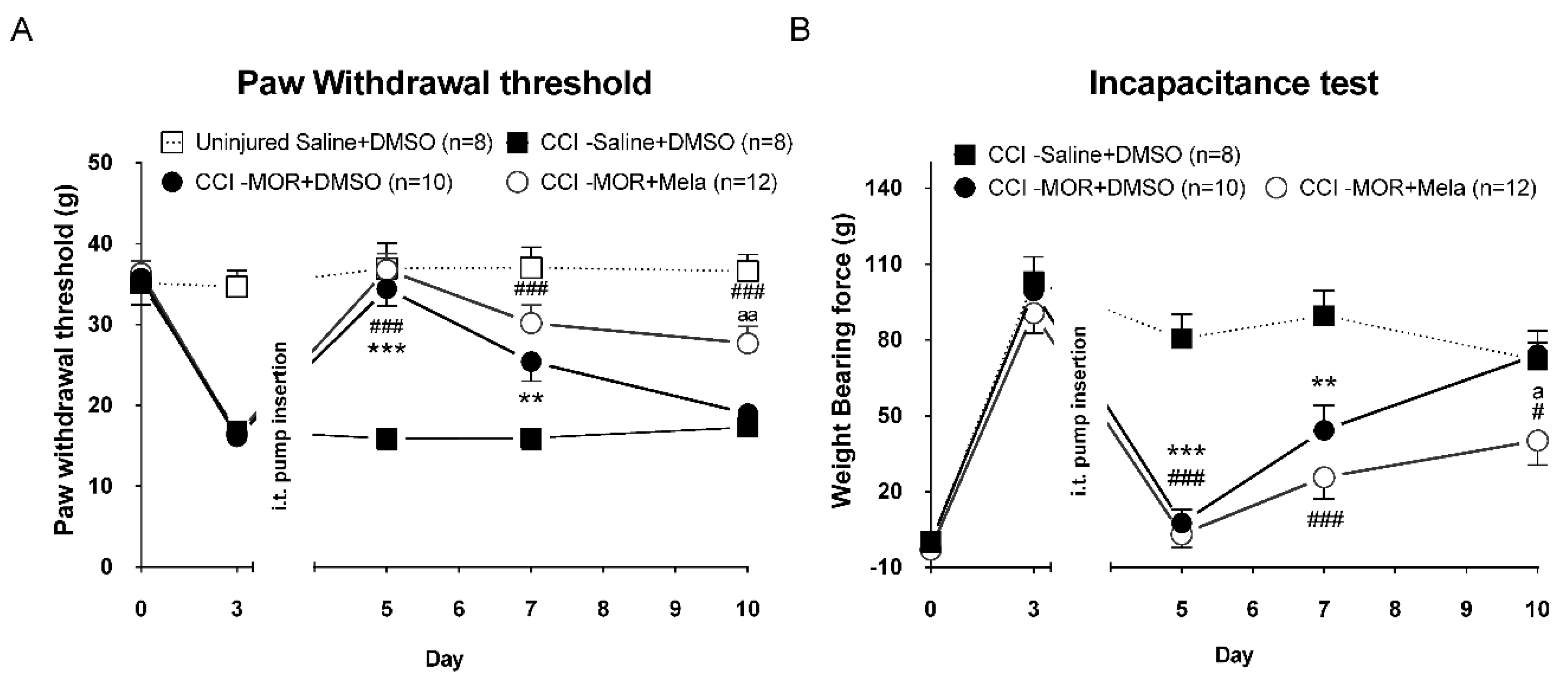
| Genes | MOR vs. Saline Control | MOR + Mela vs. Saline Control | ||||||||
|---|---|---|---|---|---|---|---|---|---|---|
| Fold Regulation | 95% CI | p-Value | Fold Regulation | 95% CI | p-Value | Pathway | ↑ Pain | ↓ Pain | Ref. | |
| Alox5 | 1.637 | (1.29, 1.98) | * 0.0151 | 1.082 | (0.88, 1.29) | 0.4274 | Inflammation | ■ | [48,49,50] | |
| Ccr2 | 4.916 | (0.00001, 9.90) | * 0.0239 | 1.603 | (0.00001, 3.30) | 0.6084 | Inflammation | ■ | [51,52,53] | |
| Cnr2 | 1.867 | (1.25, 2.49) | * 0.0204 | 1.399 | (0.75, 2.05) | 0.2291 | Cannabinoid receptors | ■ | [54,55] | |
| Gdnf | 2.001 | (1.08, 2.92) | 0.0768 | 1.067 | (0.73, 1.40) | 0.7764 | Neurotrophin | ■ | [56,57] | |
| Il10 | 6.324 | (1.49, 11.16) | * 0.0112 | 1.165 | (0.38, 1.95) | 0.8258 | Inflammation | ■ | [58,59] | |
| Il1a | 1.545 | (1.10, 1.99) | * 0.0353 | −1.172 | (0.42, 1.28) | 0.6572 | Inflammation | ■ | [60,61,62] | |
| Il6 | 3.177 | (0.90, 5.45) | * 0.0191 | 1.354 | (0.41, 2.30) | 0.5021 | Inflammation | ■ | [53,63] | |
| Kcnip3 | 1.036 | (0.85, 1.22) | 0.7624 | 1.342 | (1.07, 1.62) | *0.0418 | Potassium channel | ■ | [64,65] | |
| Pla2g1b | 1.637 | (1.21, 2.06) | * 0.0399 | −1.219 | (0.47, 1.17) | 0.5058 | Eicosanoid metabolism | ■ | [66] | |
| Prok2 | 3.920 | (0.97, 6.87) | *0.0333 | 1.455 | (0.62, 2.29) | 0.2562 | Inflammation | ■ | [67,68] | |
| Ptger3 | 1.974 | (1.09, 2.86) | * 0.0493 | 1.339 | (0.74, 1.94) | 0.2369 | Eicosanoid metabolism | ■ | [69,70] | |
| Ptger4 | 1.330 | (1.09, 1.57) | * 0.0366 | 1.246 | (0.98, 1.51) | 0.1199 | Eicosanoid metabolism | ■ | [71] | |
| Scn11a | 4.996 | (2.38, 7.61) | * 0.0203 | 1.072 | (0.79, 1.35) | 0.6871 | Sodium channel | ■ | [72] | |
| Tnf | 2.923 | (0.87, 4.97) | * 0.0328 | 1.702 | (0.47, 2.93) | 0.2336 | Inflammation | ■ | [53,63] | |
| Trpa1 | 3.366 | (1.96, 4.77) | * 0.0184 | 1.182 | (0.95, 1.41) | 0.1638 | Ion channel | ■ | [73,74] | |
| Trpv1 | 1.415 | (1.10, 1.73) | * 0.0400 | 1.048 | (0.79, 1.31) | 0.7101 | Ion channel | ■ | [73,74,75] | |
© 2020 by the authors. Licensee MDPI, Basel, Switzerland. This article is an open access article distributed under the terms and conditions of the Creative Commons Attribution (CC BY) license (http://creativecommons.org/licenses/by/4.0/).
Share and Cite
Chen, I.-J.; Yang, C.-P.; Lin, S.-H.; Lai, C.-M.; Wong, C.-S. The Circadian Hormone Melatonin Inhibits Morphine-Induced Tolerance and Inflammation via the Activation of Antioxidative Enzymes. Antioxidants 2020, 9, 780. https://doi.org/10.3390/antiox9090780
Chen I-J, Yang C-P, Lin S-H, Lai C-M, Wong C-S. The Circadian Hormone Melatonin Inhibits Morphine-Induced Tolerance and Inflammation via the Activation of Antioxidative Enzymes. Antioxidants. 2020; 9(9):780. https://doi.org/10.3390/antiox9090780
Chicago/Turabian StyleChen, Ing-Jung, Chih-Ping Yang, Sheng-Hsiung Lin, Chang-Mei Lai, and Chih-Shung Wong. 2020. "The Circadian Hormone Melatonin Inhibits Morphine-Induced Tolerance and Inflammation via the Activation of Antioxidative Enzymes" Antioxidants 9, no. 9: 780. https://doi.org/10.3390/antiox9090780
APA StyleChen, I.-J., Yang, C.-P., Lin, S.-H., Lai, C.-M., & Wong, C.-S. (2020). The Circadian Hormone Melatonin Inhibits Morphine-Induced Tolerance and Inflammation via the Activation of Antioxidative Enzymes. Antioxidants, 9(9), 780. https://doi.org/10.3390/antiox9090780




